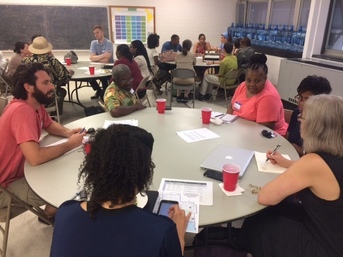|
In March 2015, the Department of Planning held a training on structural racism in response to staff interest.
This training came at a critical time, directly preceding the Uprising in April.
The April 2015 events motivated Departmental planners to act, organizing an
Equity in Planning Committee (EIPC), with staff from all Divisions
participating.
The
Equity in Planning Committee (EIPC) meets monthly to understand and work
against the legacy and historical drivers of racism and inequity that have
resulted in significant gaps in opportunity between black and white populations
in Baltimore. Through lunchtime brown bag lunch discussions, staff
presentations on the history of structural racism in Baltimore, and panel
discussions featuring speakers from organizations such as the Baltimore
Integration Partnership and Invested Impact, the Committee makes equity part of
the day-to-day departmental conversation.
The EIPC
is elevating equity as a priority for Departmental initiatives and programs. Through
the development of the Equity Action Plan, the EIPC formulated recommendations that
the Department of Planning can undertake to integrate equity more effectively
into planning programs and policies. For example, the Equity Action Plan
recommends integrating equity into the Capital Improvement Program process;
developing a neighborhood Leadership Academy; and empowering residents to become
involved in shaping the future of their neighborhoods. The EIPC aims for the
Department of Planning to be a leader, at the forefront of integrating equity
into our work among planning departments nationwide.
Drawing from resources developed by the Urban
Sustainability Directors Network, EIPC is proposing
the application of an equity lens to policies and projects. This lens
encourages planners to consider several questions:
-
What historic
advantages or disadvantages have residents faced?
-
How can planning
processes be more inclusive and accessible to residents who have been
historically excluded from public decision-making processes?
-
How can
resources be distributed in a way that accounts for historical disadvantages?
-
How can plans
encourage policies to curb and counteract generational inequities?
 Current planning processes underway grapple with these
questions. For example, the Sustainability Plan Update process, from the start,
focused on making the process inclusive. Rather than a relying on the
traditional model of holding large public meetings lead by staff, the Office of
Sustainability recruited and trained resident ambassadors to lead the public
engagement process at the neighborhood level. These 125 ambassadors surveyed
their friends and neighbors about issues that mattered most to them. The survey
questions focused broadly on resident perceptions of their own neighborhood,
and could be conducted in a living room or around a kitchen table.
This network
of Sustainability Ambassadors was divided up
into teams, and each was assigned a Lead Ambassador and provided funding
for team
building – to purchase t-shirts or meals for their volunteers. The
Ambassadors were
encouraged to connect with their neighbors at public events, farmers
markets, fairs and shopping areas. The purpose of this approach was to
reach members of the
community that were less likely to participate in the public planning
process –
those who did not have the time to attend evening public meetings. The
vision for the process was
captured in the #EveryStoryCounts social media campaign, which
encouraged the
public to share their sustainability stories through Twitter, Instagram
or
Facebook.
In March of 2017, the Department of Planning invited Skeo
Solutions to conduct a mandatory staff-wide training on diversity, equity and
inclusion. The goal of this training was to establish a strong foundation for a
departmental culture that promotes inclusive and equitable planning.
This year, Maryland’s Commission on Environmental Justice and
Sustainability is developing a case study on the Department of Planning’s
efforts around social justice and equity. This study will highlight, in further
depth, some of the work undertaken by the EIPC and the Sustainability Plan
Update. Moving forward, the Department of Planning will pilot new approaches to
working with Baltimore residents collaboratively. This will include moving
meetings outside of traditional venues and into the community through pop-up
neighborhood events. Anticipate seeing Planners outside of the office and on
your block in the months to come!
Where are you originally from, and what brought you to Baltimore?
Marshella: I was born in Philadelphia, Pennsylvania on a tree-lined
block on the West side of the City. After completing graduate school, my first
full-time planning position was with the City of Charleston, South
Carolina. In Charleston, I became very interested in integrating small area
housing redevelopment strategies into the overall planning process for the
neighborhoods. One evening, as I was watching television, I happened upon
a documentary about the housing redevelopment story in Baltimore. I was
so intrigued that I decided at that moment to find a way to become a part of
the work that was ongoing in Baltimore.
What are your responsibilities here at the Department of Planning? What
projects are you most excited to work on in 2017?
Marshella: As a Community Planner, I am responsible for
working with community organizations and businesses, in partnership with
Department of Planning colleagues, sister agencies, elected officials,
and other stakeholders to advance the planning process for communities,
effectively communicate development activities, participate in the development
review process, and respond to requests for information – keeping the equity
focus at the forefront of this work.
In
fairness to the all of the great Eastern neighborhoods, I won’t select favorite
projects– the wide-ranging and diverse Eastern District is enhanced by exciting
projects throughout several neighborhoods. I will say that those projects
that provide connections to other neighborhoods are exciting prospects.
What recommendation from the Equity Committee’s Equity in Planning
Action Plan do you most hope to see realized?
Marshella: I would like to see the development of a toolkit of strategies to accompany
the housing market typology. Housing is a basic need for all, and a
neighborhood’s housing stock is one of its defining characteristics. The toolkit should provide
communities with the resources and inspiration to move beyond
perceived market barriers.
|